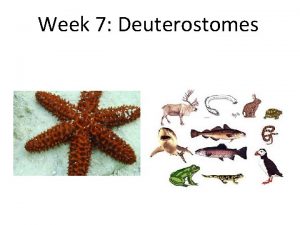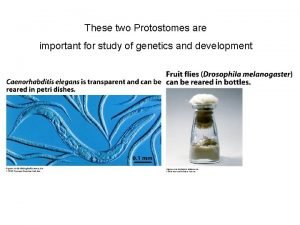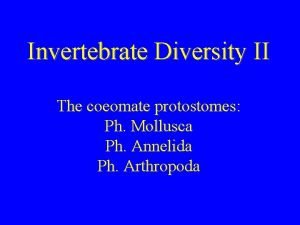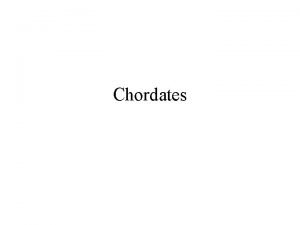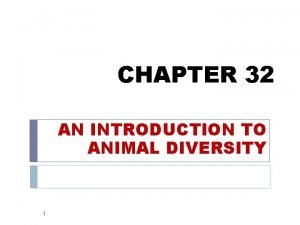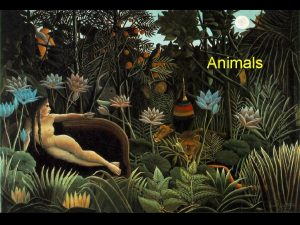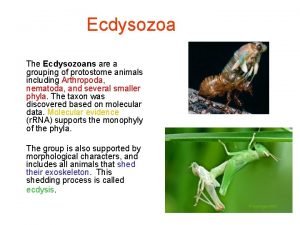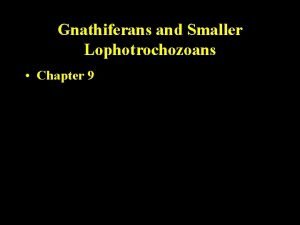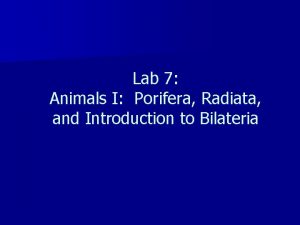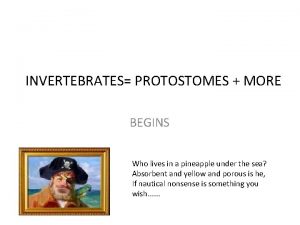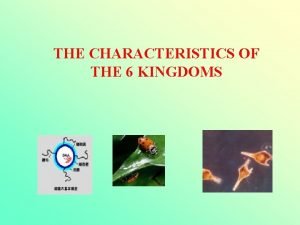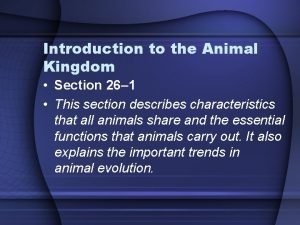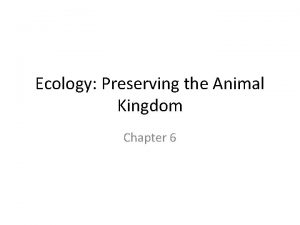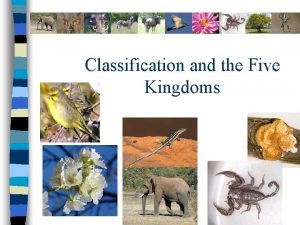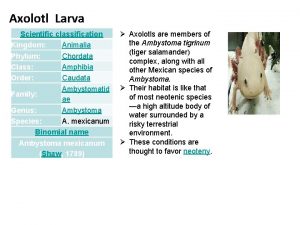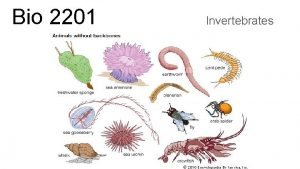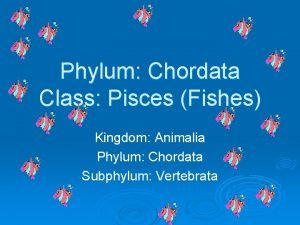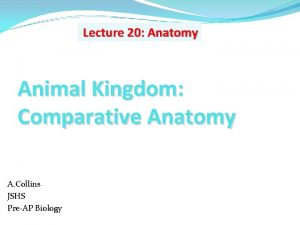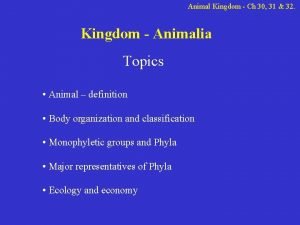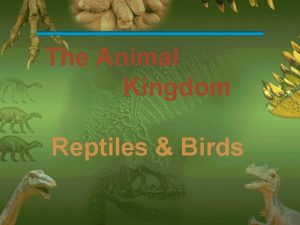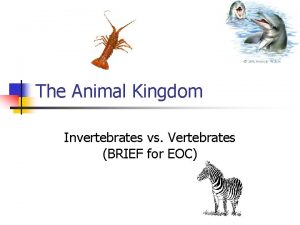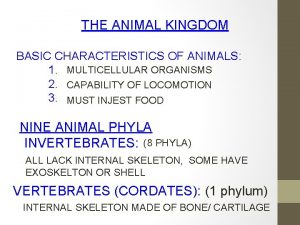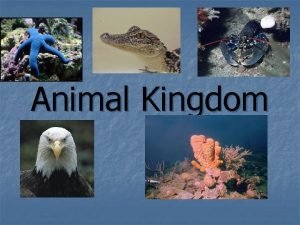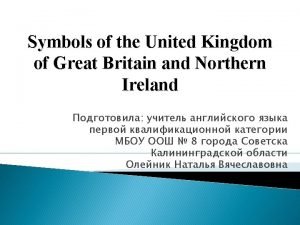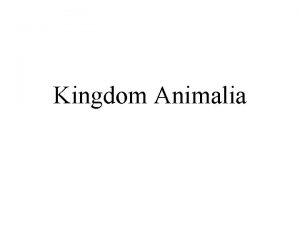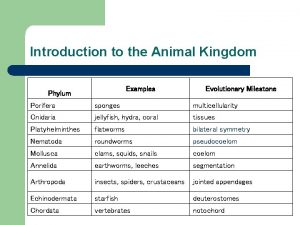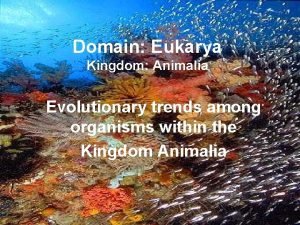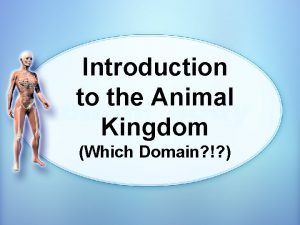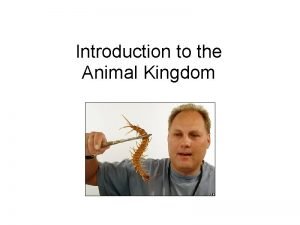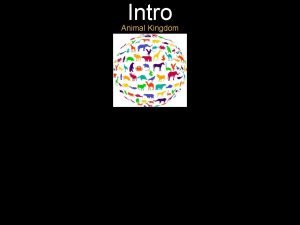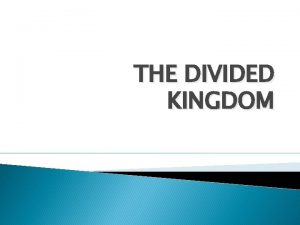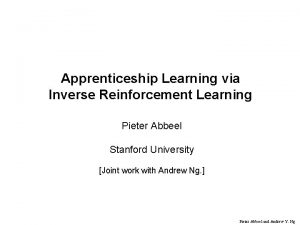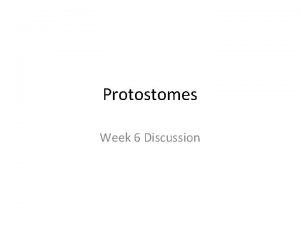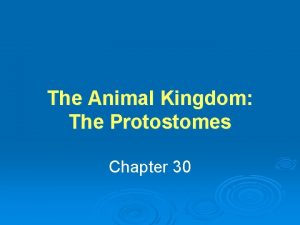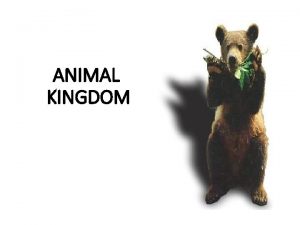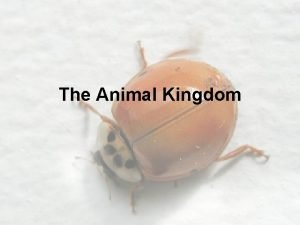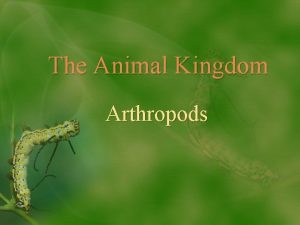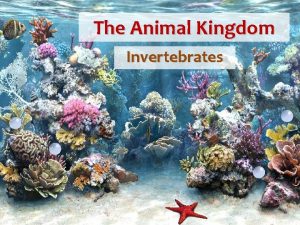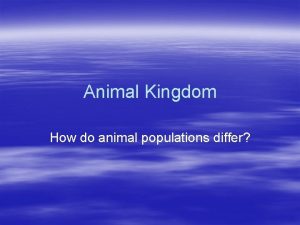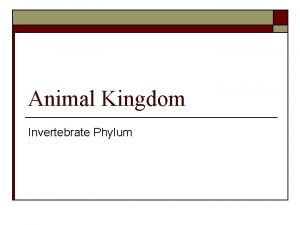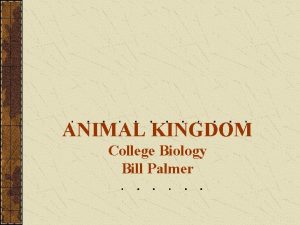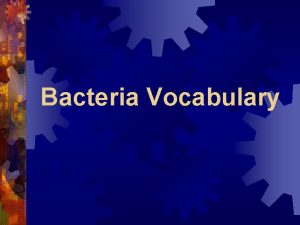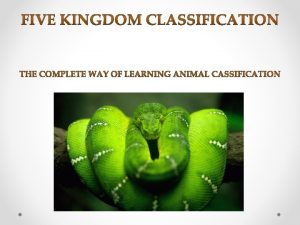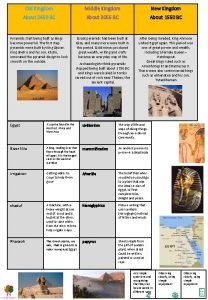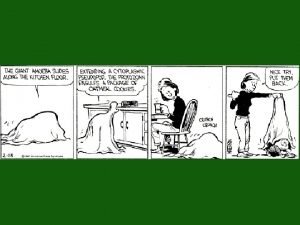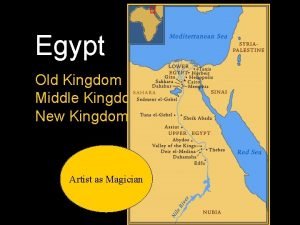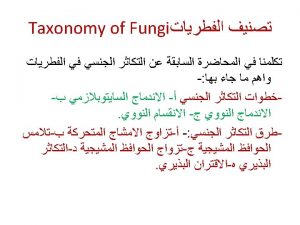The Animal Kingdom The Protostomes Chapter 30 Learning












































































































- Slides: 108

The Animal Kingdom: The Protostomes Chapter 30

Learning Objective 1 • Cite specific examples of the evolutionary significance of the coelom

Coelom 1 • True coelom is a fluid-filled body cavity • • completely lined by mesoderm between digestive tube and outer body wall Allows tube-within-a-tube body plan • • body wall is outer tube inner tube is digestive tube

Coelom 2 • An enclosed compartment (or series of compartments) of fluid under pressure • Serve as hydrostatic skeleton • contracting muscles push against tube of fluid

Coelom 3 • A space in which internal organs develop • including gonads • Helps transport materials • Protects internal organs

KEY CONCEPTS • Evolution of the coelom has been associated with important innovations in body plan, including cephalization, the tube-within-a-tube body plan, compartmentalization, and segmentation

Learning Objective 2 • Characterize the protostomes • Describe their two main evolutionary branches • Give examples of animals assigned to each branch

Protostomes • Characterized by • • • spiral cleavage determinate cleavage development of mouth from blastopore

Two Branches of Protostomes • Lophotrochozoa • • platyhelminths, nemerteans, mollusks, annelids, lophophorate phyla, rotifers Ecdysozoa • nematodes (roundworms) and arthropods

KEY CONCEPTS • Protostomes are a monophyletic group that gave rise to two major clades: Lophotrochozoa and Ecdysozoa

Learning Objective 3 • What are the distinguishing characteristics of phylum Nemertea and phylum Platyhelminthes? • Describe the main classes of phylum Platyhelminthes, giving examples of animals that belong to each class

Phylum Nemertea (Ribbon Worms) 1 • Characterized by proboscis • • muscular tube for capturing food, defense Reduced coelom (rhynchocoel) • space surrounding proboscis

Phylum Nemertea (Ribbon Worms) 2 • Nemerteans have • • • tube-within-a-tube body plan complete digestive tract with mouth and anus a circulatory system

Nemerteans

Phylum Platyhelminthes (Flatworms) 1 • Acoelomate animals with • • • bilateral symmetry cephalization 3 definite tissue layers well-developed organs Many are hermaphrodites • single animal produces both sperm and eggs

Phylum Platyhelminthes (Flatworms) 2 • Ladder-type nervous system • • sense organs simple brain composed of two ganglia 2 nerve cords that extend the length of body Protonephridia • function in osmoregulation and disposal of metabolic wastes

3 Classes of Phylum Platyhelminthes • Class Turbellaria • • Classes Trematoda and Monogenea • • free-living flatworms, including planarians parasitic flukes Class Cestoda • parasitic tapeworms

Planarian

Choanoflagellate ancestor Deuterostomia Ecdysozoa Rotifera Lophophorate phyla Annelida Mollusca Nemertea Platyhelminthes Radiata Parazoa Lophotrochozoa Fig. 30 -1 (1), p. 642

Ganglia Auricle Eyespot Nerve Gastrovascular cavity Pharynx Sheath surrounding pharynx Mouth 1 mm Fig. 30 -1 ab, p. 642

Pharyngeal sheath cavity Pharyngeal cavity Inner muscle layer of pharynx Outer muscle layer Muscle Epidermis Sperm mass Ventral nerve cords Adhesive gland Cilia Muscle layers Body wall composed of epidermis, circular muscle, and longitudinal muscle Fig. 30 -1 c, p. 642

Insert “Planarian organ systems” planarian_organs_v 2. swf

Parasitic Flukes and Tapeworms • Typically have suckers or hooks • • for holding on to their hosts Have complicated life cycles • • intermediate hosts large numbers of eggs

Parasitic Fluke

2 Larvae make their way to circulatory system, where they mature. During reproduction, which takes place in veins, male holds female in a long groove. 1 Larvae burrow through skin. 1 mm 3 Eggs pass into intestine. 7 Finally, forktailed larvae (cercariae) develop and leave snail. 4 Eggs containing developing embryos are excreted with feces. 6 Larvae must enter a second host, a freshwater snail. After burrowing into tissues of snail, larvae develop into a form that reproduces asexually. 5 If they find their way to fresh water, the eggs hatch, releasing free-swimming larvae (miracidia). Fig. 30 -2, p. 644

Tapeworm

Insert “Blood fluke lifecycle” and “Tapeworm life cycle” blood_fluke. swf tapeworm. swf

Watch the fluke and tapeworm life cycles by clicking on the figures in Thomson. NOW.

Learning Objective 4 • What are the adaptive advantages of cephalization?

Cephalization • Evolution of a head • • • concentration of sense organs and nerve cells (simple brain) at anterior end (Flatworms show beginnings of cephalization) Increases effectiveness of bilateral animal • • to actively find food, shelter, mates to detect enemies

Learning Objective 5 • What are the distinguishing characteristics of phylum Mollusca and the four molluscan classes discussed? • Give examples

Phylum Mollusca • Soft-bodied animals • • Ventral foot • • usually covered by a shell for locomotion Mantle • covers visceral mass (body organs)

Mollusks • Most have open circulatory system • • Most have rasplike radula for feeding • • Cephalopods have closed circulatory system Bivalves are suspension feeders Most marine mollusks have freeswimming, ciliated trochophore larva

Insert “Molluscan classes” mollusk_classes. swf

Trochophore Larva

Digestive tract Cilia Mouth Nephridium Mesodermal cells Anus Fig. 30 -7, p. 648

Class Polyplacophora Includes marine chitons • Shells consist of 8 overlapping plates •

Shell Digestive tract Class Polyplacophora Fig. 30 -6 a, p. 647

Class Gastropoda • Largest group of mollusks • • snails, slugs, and their relatives Body undergoes torsion • a twisting of the visceral mass

Shell Foot Digestive tract Class Gastropoda Fig. 30 -6 b, p. 647

Insert “Snail body plan” snail_body_plan. swf

Torsion

Insert “Torsion in gastropods” torsion. swf

Class Bivalvia • Includes aquatic clams, scallops, oysters • Two-part shell • • • hinged dorsally encloses bodies Suspension feeders

Shell Digestive Foot tract Class Bivalva Fig. 30 -6 c, p. 647

Clam

Heart Digestive gland Stomach DORSAL Metanephridium Intestine Esophagus Posterior adductor muscle Anus Ganglion Anterior adductor muscle Excurrent siphon Incurrent siphon Mouth Palp Pedal ganglion Gill—partially cut Mantle Foot Shell Intestine Gonad VENTRAL Fig. 30 -10, p. 649

Insert “Clam body plan” clam. swf

Class Cephalopoda • Includes squids, octopods, Nautilus • Active, predatory swimmers • Tentacles surround the mouth • located in the large head

Tentacles (modified foot) Internal shell Digestive tract Class Cephalopoda Fig. 30 -6 d, p. 647

Learning Objective 6 • What are the distinguishing characteristics of phylum Annelida and the three annelid classes discussed? • Give examples

Phylum Annelida (Segmented Worms) • Aquatic worms, earthworms, leeches • Conspicuously long bodies • Segmentation • • both internally and externally Large, compartmentalized coelom • serves as hydrostatic skeleton

Annelids

Mouth Setae Clitellum Suckers Parapodia Anus Class Polychaeta Class Oligochaeta Class Hirudinea Fig. 30 -11 (a-c), p. 650

Setae Deuterostomia Ecdysozoa Rotifera Lophophorate phyla Annelida Mollusca Nemertea Platyhelminthes Radiata Parazoa Lophotrochozoa Mouth Clitellum Suckers Parapodia Choanoflagellate ancestor Anus Class Polychaeta Class Oligochaeta Class Hirudinea Stepped Art Fig. 30 -11 (a-c), p. 650

Earthworm

Clitellum Intestine Gizzard Crop Esophagus Pharynx Dorsal vessel Ventral vessel Muscles Longitudinal Circular Septa Nerve cord Mouth Cerebral ganglia Fig. 30 -12 a, p. 651

Intestine Dorsal blood vessel Metanephridia Coelom Ventral blood vessel Nerve cord Fig. 30 -12 b, p. 651

Insert “Earthworm body plan” earthworm_v 2. swf

Leeches

Class Polychaeta • Marine worms with parapodia • appendages for locomotion, gas exchange • Parapodia have many setae • Well-defined head with sense organs • unlike other annelids

Class Oligochaeta • Earthworms • Characterized by few short setae per segment • Body divided into > 100 segments • separated internally by septa

Class Hirudinea • Leeches • Characterized by absence of setae and appendages • Parasitic leeches have suckers • for holding on to their host

Learning Objective 7 • What are the distinguishing characteristics of the lophophorate phyla?

The Lophophorate Phyla • Marine animals with a lophophore • • brachiopods, phoronids, bryozoans Lophophore • • ciliated ring of tentacles surround the mouth specialized to capture particles in water

Lophophorates • Phylum Brachiopoda • Phylum Phoronida • Phylum Bryozoa

Deuterostomia Ecdysozoa Rotifera Lophophorate phyla Annelida Mollusca Nemertea Platyhelminthes Radiata Parazoa Lophotrochozoa Choanoflagellate ancestor Fig. 30 -14 (1), p. 653

Phylum Rotifera

Deuterostomia Ecdysozoa Rotifera Lophophorate phyla Annelida Mollusca Nemertea Platyhelminthes Radiata Parazoa Lophotrochozoa Choanoflagellate ancestor Fig. 30 -15 (1), p. 654

150 µm Fig. 30 -15 a, p. 654

Crown of cilla Mouth Eyespot Pharynx (grinding organ) Digestive glands Stomach Reproductive organ Intestine Protonephridium Bladder Anus Cuticle and epidermis Fig. 30 -15 b, p. 654

Learning Objective 8 • What are the distinguishing characteristics of phylum Nematoda?

Phylum Nematoda (Roundworms) • Highly successful ecdysozoans • Pseudocoelom • Body covered by tough cuticle • helps prevent desiccation

Phylum Nematoda (Roundworms) • Parasitic nematodes in humans • • Ascaris hookworms trichina worms pinworms

Ascaris

Mouth Pharynx Dorsal nerve Excretory canal Excretory gland Pharynx Muscle of pharynx wall Pseudocoelom Uterus Ovary Intestine Excretory canal Vulva Muscle layer Epidermis Ventral nerve Cuticle (b) Cross section Anus (a) Longitudinal section Fig. 30 -17, p. 656

Learning Objective 9 • What are the distinguishing characteristics of phylum Arthropoda? • Distinguish among the subphyla and classes of this phylum • Give examples of animals that belong to each group

Phylum Arthropoda 1 • Segmented animals with paired, jointed appendages • Armorlike exoskeleton of chitin • Molting necessary for arthropod to grow

Phylum Arthropoda 2 • Open circulatory system • dorsal heart, pumps hemolymph • Aquatic forms have gills for gas exchange • Terrestrial forms have either tracheae or book lungs

KEY CONCEPTS • The most biologically successful protostomes in terms of diversity and numbers are the mollusks and the arthropods

Trilobites • Extinct marine arthropods • • covered by hard, segmented shell Each segment had a pair of biramous appendages with two jointed branches • • inner walking leg outer gill branch

Trilobites

Deuterostomia Arthropoda Nematoda Lophotrochozoa Radiata Parazoa Ecdysozoa Choanoflagellate ancestor Fig. 30 -19 (1), p. 658

Antenna Head Eye Gill Lateral lobe Median lobe (a) Dorsal view of a trilobite. (b) Ventral view. Fig. 30 -19 ab, p. 658

Subphylum Myriapoda • 2 Classes • • Chilopoda (centipedes) Diplopoda (millipedes) • Uniramous (unbranched) appendages • Single pair of antennae

Myriapods

Subphylum Chelicerata 1 • Merostomes (horseshoe crabs) and Arachnids (spiders, mites, and relatives) • Body with cephalothorax and abdomen • 6 pairs of uniramous, jointed appendages • 4 pairs serve as legs

Subphylum Chelicerata 2 • First appendages are chelicerae • second are pedipalps • Appendages adapted for manipulation of food, locomotion, defense, copulation • No antennae, no mandibles

Chelicerates

Subphylum Crustacea 1 • Lobsters, crabs, shrimp, pill bugs, barnacles • Body with cephalothorax and abdomen • Most have five pairs of walking legs • Appendages are biramous

Subphylum Crustacea 2 • Two pairs of antennae • • Third appendages are mandibles • • sense taste and touch for chewing Two pairs of maxillae • • posterior to mandibles manipulate and hold food

Crustaceans

Lobster

Cephalothorax Abdomen Thorax Head Eye Fifth walking leg Fig. 30 -23 a, p. 661

Tail fan Fifth walking leg Second walking leg Mouth Third maxilliped Cheliped First antenna Second antenna Swimmerets First swimmeret (used by male in copulation) Fig. 30 -23 b, p. 661

Subphylum Hexapoda • Includes class Insecta • articulated, tracheated hexapods

Head Thorax Abdomen Forewing Antenna Simple eye Compound eye Sound receptor Spiracles Hindwing (a) External structure. Note three pairs of segmented legs. Fig. 30 -24 a, p. 661

Insects • • • Body with head, thorax, and abdomen Uniramous appendages Single pair of antennae Tracheae for gas exchange Malpighian tubules for excretion

Grasshopper Ovary Digestive gland Heart Anus Brain Nerve cord Malpighian tubules (b) Internal Anatomy. Intestine Genital opening

Learning Objective 10 • What adaptations have contributed to the biological success of insects?

Insect Adaptations 1 • • • Versatile exoskeleton Segmentation Specialized jointed appendages Highly developed sense organs Ability to fly

Insert “Insect head parts” insect_heads. swf

Insect Adaptations 2 • Metamorphosis • • transition from one developmental form to another reduces intraspecific competition

Metamorphosis

Insert “Insect development” insect_devt. swf

Insect Adaptations 3 • Insects have developed • • • effective reproductive strategies effective mechanisms for defense, offense ability to communicate

KEY CONCEPTS • The remarkable biological success of the insects can be attributed to the evolution of complex body plans and life cycles, for example, their exoskeleton, segmentation, specialized jointed appendages, ability to fly, and metamorphosis

Explore the body plans of the protostomes by clicking on the figures in Thomson. NOW.
 Old kingdom middle kingdom new kingdom
Old kingdom middle kingdom new kingdom Nnn ruled
Nnn ruled Youtube egypt
Youtube egypt Capital of egypt during the old kingdom
Capital of egypt during the old kingdom Deuterostome vs protostome
Deuterostome vs protostome Are crustaceans protostomes
Are crustaceans protostomes Feather duster worm protostome or deuterostome
Feather duster worm protostome or deuterostome Porife
Porife Protostome vs deuterostome
Protostome vs deuterostome Germ layers
Germ layers Protostomes vs deuterostomes
Protostomes vs deuterostomes Subphylum chelicerata
Subphylum chelicerata Smaller
Smaller Radiata animals
Radiata animals Are snails coelomates pseudocoelomates or acoelomates
Are snails coelomates pseudocoelomates or acoelomates Protista mobility
Protista mobility Plantae kingdom drawing
Plantae kingdom drawing Domain
Domain The odds and ends kingdom
The odds and ends kingdom Cuadro comparativo de e-learning b-learning y m-learning
Cuadro comparativo de e-learning b-learning y m-learning Characteristic of animal
Characteristic of animal Small white bear
Small white bear It divides organisms into small groups
It divides organisms into small groups 26-1 introduction to the animal kingdom
26-1 introduction to the animal kingdom Horse class taxonomy
Horse class taxonomy Ecology preserving the animal kingdom
Ecology preserving the animal kingdom Animal pyramid kingdom
Animal pyramid kingdom What kingdom is axolotl in
What kingdom is axolotl in Cladogram of animal kingdom
Cladogram of animal kingdom Cladogram of 6 kingdoms
Cladogram of 6 kingdoms Morgan animal kingdom
Morgan animal kingdom Invertebrate digestive system
Invertebrate digestive system Pisces in animal kingdom
Pisces in animal kingdom Animal kingdom
Animal kingdom Carl linnaeus animal kingdom
Carl linnaeus animal kingdom Animal kingdom
Animal kingdom Reptiles order
Reptiles order Animal kingdom vertebrates and invertebrates
Animal kingdom vertebrates and invertebrates Basic characteristics of animals
Basic characteristics of animals Animal kingdom taxonomy chart
Animal kingdom taxonomy chart Domain eukarya, kingdom animalia (or animal)
Domain eukarya, kingdom animalia (or animal) Animal kingdom basis of classification
Animal kingdom basis of classification Animals that have no bones
Animals that have no bones Uk national animal
Uk national animal Animalia kingdom characteristics
Animalia kingdom characteristics Are humans in the animal kingdom
Are humans in the animal kingdom Coelom
Coelom 8 phyla of invertebrates
8 phyla of invertebrates There are many types of lethal venom in the animal kingdom
There are many types of lethal venom in the animal kingdom Domain animal kingdom
Domain animal kingdom Anamalia characteristics
Anamalia characteristics Animal kingdom intro
Animal kingdom intro Kingdom care daycare
Kingdom care daycare Venn diagram of plant and animal cells
Venn diagram of plant and animal cells Plant cell vs animal cell venn diagram
Plant cell vs animal cell venn diagram Similarities between animal rights and animal welfare
Similarities between animal rights and animal welfare Hình ảnh bộ gõ cơ thể búng tay
Hình ảnh bộ gõ cơ thể búng tay Lp html
Lp html Bổ thể
Bổ thể Tỉ lệ cơ thể trẻ em
Tỉ lệ cơ thể trẻ em Gấu đi như thế nào
Gấu đi như thế nào Chụp tư thế worms-breton
Chụp tư thế worms-breton Alleluia hat len nguoi oi
Alleluia hat len nguoi oi Môn thể thao bắt đầu bằng từ đua
Môn thể thao bắt đầu bằng từ đua Thế nào là hệ số cao nhất
Thế nào là hệ số cao nhất Các châu lục và đại dương trên thế giới
Các châu lục và đại dương trên thế giới Công của trọng lực
Công của trọng lực Trời xanh đây là của chúng ta thể thơ
Trời xanh đây là của chúng ta thể thơ Mật thư anh em như thể tay chân
Mật thư anh em như thể tay chân 101012 bằng
101012 bằng Phản ứng thế ankan
Phản ứng thế ankan Các châu lục và đại dương trên thế giới
Các châu lục và đại dương trên thế giới Thể thơ truyền thống
Thể thơ truyền thống Quá trình desamine hóa có thể tạo ra
Quá trình desamine hóa có thể tạo ra Một số thể thơ truyền thống
Một số thể thơ truyền thống Cái miệng nó xinh thế
Cái miệng nó xinh thế Vẽ hình chiếu vuông góc của vật thể sau
Vẽ hình chiếu vuông góc của vật thể sau Thế nào là sự mỏi cơ
Thế nào là sự mỏi cơ đặc điểm cơ thể của người tối cổ
đặc điểm cơ thể của người tối cổ V cc
V cc Vẽ hình chiếu đứng bằng cạnh của vật thể
Vẽ hình chiếu đứng bằng cạnh của vật thể Fecboak
Fecboak Thẻ vin
Thẻ vin đại từ thay thế
đại từ thay thế điện thế nghỉ
điện thế nghỉ Tư thế ngồi viết
Tư thế ngồi viết Diễn thế sinh thái là
Diễn thế sinh thái là Các loại đột biến cấu trúc nhiễm sắc thể
Các loại đột biến cấu trúc nhiễm sắc thể Số nguyên tố là số gì
Số nguyên tố là số gì Tư thế ngồi viết
Tư thế ngồi viết Lời thề hippocrates
Lời thề hippocrates Thiếu nhi thế giới liên hoan
Thiếu nhi thế giới liên hoan ưu thế lai là gì
ưu thế lai là gì Khi nào hổ con có thể sống độc lập
Khi nào hổ con có thể sống độc lập Khi nào hổ con có thể sống độc lập
Khi nào hổ con có thể sống độc lập Sơ đồ cơ thể người
Sơ đồ cơ thể người Từ ngữ thể hiện lòng nhân hậu
Từ ngữ thể hiện lòng nhân hậu Thế nào là mạng điện lắp đặt kiểu nổi
Thế nào là mạng điện lắp đặt kiểu nổi A kingdom divided
A kingdom divided Supervised learning dan unsupervised learning
Supervised learning dan unsupervised learning Concept learning task in machine learning
Concept learning task in machine learning Analytical learning in machine learning
Analytical learning in machine learning Non associative learning meaning
Non associative learning meaning Eager classification versus lazy classification
Eager classification versus lazy classification Deductive learning vs inductive learning
Deductive learning vs inductive learning Focl in machine learning
Focl in machine learning Apprenticeship learning via inverse reinforcement learning
Apprenticeship learning via inverse reinforcement learning Apprenticeship learning via inverse reinforcement learning
Apprenticeship learning via inverse reinforcement learning Deductive vs inductive
Deductive vs inductive




